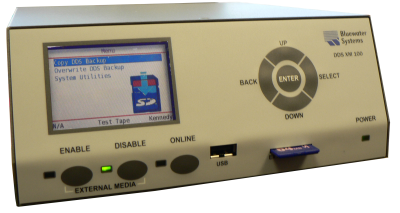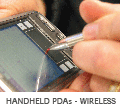Display
Introduction
Many embedded devices need some form of display to communicate information to the user. Liquid Crystal Displays (LCD) are popular for embedded devices because they are small and have low power requirements.
An LCD display works by shining a bright white light (the 'backlight') through a vertical and a horizontal polarising filter connected by liquid crystals and then through a colour filter. The liquid crystals rotate the light so that is able to pass through both filters and by applying a voltage to the crystals the amount of pass-through can be controlled. The filter arrangement absorbs from half to all of the light emitted by the backlight, which is generally some sort of high voltage flourescent tube. This means that LCD displays are not as efficient on power and one might light, and do generate some heat.
LCD panels for embedded use come in various shapes and sizes, and a wide number of resolutions are supported. They are typically very thin, around 5mm, and are usually attached via a flat ribbon connector. The flat ribbon connectors allow a reasonable amount of freedom in the placement of an embedded LCD panel in a compact embedded device.
Touchscreens
Touchscreen LCD displays are able to register pressure on the surface of the LCD as a form of input. A user can user either a stylus or a finger on the screen to control the device. Some touchscreen applications are relatively simple, providing the user with a number of buttons to press. Other interfaces, such as Windows CE, use touchscreens as a full replacement for a mouse and keyboard. The stylus can be use to move the mouse cursor, and tapping the stylus acts as a mouse click. Keyboard replacement is either achieved through use of handwriting recognition software, or a virtual keyboard displayed on screen.
LVDS
Low voltage differential signalling (LVDS) is often used for transmitting data to LCD screens, especially embedded LCD panels. The FPD-Link and OpenLDI standards use LVDS to transmit data to LCD displays. Using these standards a maximum pixel clock of 112Mhz is possible. This allows for high resolutions (over 1280x1024) at 60Hz refresh rate.
Bluewater Systems Experience
Bluewater Systems have used a number of different LCD displays on embedded units.
The DDS-XM100 Series
The DDS-XM100 Digital data storage units use a Sony ACX705AKM LCD display. The display measures 71mm by 52mm with a thickness of 5mm, and provides a viewable resolution of 240x160 in 16 bit colour. Although the LCD is small, it provides enough space to display the necessary information and reduces both the cost and the size of the DDS units.
LVDS Displays
Most ARM microprocessors do not support LVDS LCD boards natively. Bluewater Systems has developed FPGA code for the Snapper 255 module which allows it to control LVDS LCD displays. Other Snapper modules can have LVDS support added to the carrier board either in hardware using a small LVDS converter chip, or using a custom FPGA. The Rig 200 LCD board uses a custom FPGA in order to support LVDS on the Snapper 255, 270 and CL15 modules.
LCD Displays on the Rig 200
Rig 200 has a standard VGA connector which can be connected to a standard desktop LCD monitor (or CRT). Using the Snapper 255 or 270 modules, video modes of 640x480 with 16 bit colour and in some cases 800x600 are possible. Using the Snapper CL15, video modes from 640x480 to 1024x768 with 16 bit colour are possible. The Snapper CL15 also has a built-in graphics accelerator which makes it superior to the other Snapper modules for graphical applications.
LCD Option Plus
The LCD Option Plus is an add-on board for Rig 200 which adds support for a wide range of embedded LCD panels, displays and touchscreens. The LCD Option Plus board is connected the Rig 200 baseboard via two flat ribbon cables, and is positioned on the Rig 200 opposite the expansion modules. The LCD option plus board uses a custom FPGA to support LVDS LCD displays on all of the supported Snapper modules. The following LCD displays are supported by the LCD Option Plus board:
- Sony ACX705AKM
- Sharp LQ035Q7DH06
- Sharp LQ064V3DG01
- Sharp LQ084V1DG21
- Sharp LQ104V1DG21
- Sharp LQ121S1DG61






